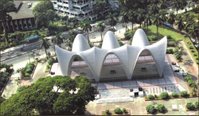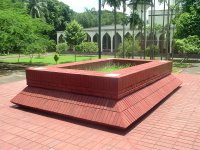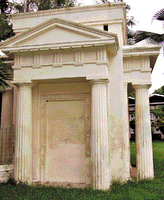

Three leaders' Mausoleum (AK Fazlul Huq, Khwaja Nazimuddin, HS Suhrawardy), near Ramna Gate
 A.K. Fazlul Huq, (1873-1962): Statesman, public leader and holder of many high political posts including Mayor of Calcutta (1935), Chief Minister of undivided Bengal (1937-1943) and East Bengal (1954), Home Minister of Pakistan (1955) and Governor of East Pakistan (1956-58). Born in Chakhar, Barisal Fazlul Huq passed BA Examination (with triple Honours in Chemistry, Mathematics and Physics) in 1894 from the Presidency College, Calcutta and obtained the MA degree in Mathematics in 1896 from the Univ of Calcutta. He obtaining the BL degree in 1897 from the University Law College.
A.K. Fazlul Huq, (1873-1962): Statesman, public leader and holder of many high political posts including Mayor of Calcutta (1935), Chief Minister of undivided Bengal (1937-1943) and East Bengal (1954), Home Minister of Pakistan (1955) and Governor of East Pakistan (1956-58). Born in Chakhar, Barisal Fazlul Huq passed BA Examination (with triple Honours in Chemistry, Mathematics and Physics) in 1894 from the Presidency College, Calcutta and obtained the MA degree in Mathematics in 1896 from the Univ of Calcutta. He obtaining the BL degree in 1897 from the University Law College. Khawaja Nazimuddin (1894-1964): Politician, Chief Minister of undivided Bengal and Governor General and Prime Minister of Pakistan. Son of Khwaja Nizamuddin, his maternal grand father was Nawab Khwaja Ahsanullah of Dhaka. He completed MA from Trinity Hall in Cambridge and Bar at Law from Middle Temple and was a member of All India Muslim League.
Khawaja Nazimuddin (1894-1964): Politician, Chief Minister of undivided Bengal and Governor General and Prime Minister of Pakistan. Son of Khwaja Nizamuddin, his maternal grand father was Nawab Khwaja Ahsanullah of Dhaka. He completed MA from Trinity Hall in Cambridge and Bar at Law from Middle Temple and was a member of All India Muslim League. Huseyn Shaheed Suhrawardy (1892-1963): Chief Minister of Bengal (1946) and Prime Minister of Pakistan (1956-57). Born of a distinguished family of Midnapur in West Bengal in 1892, HS Suhrawardy obtained BSc (Hons.) and BCL degrees from Oxford University and later on, was called to the Bar at Gray's Inn, London. In 1920 he returned to India and got involved in active politics.
Huseyn Shaheed Suhrawardy (1892-1963): Chief Minister of Bengal (1946) and Prime Minister of Pakistan (1956-57). Born of a distinguished family of Midnapur in West Bengal in 1892, HS Suhrawardy obtained BSc (Hons.) and BCL degrees from Oxford University and later on, was called to the Bar at Gray's Inn, London. In 1920 he returned to India and got involved in active politics.

Mausoleum of Sheikh Mujibur Rahman
(Bangabandhu) Sheikh Mujibur Rahman (1920-1975): Charismatic leader, President and Prime Minister of Bangladesh was born in Tungipara Gopalganj. He was the founding member of the East Pakistan Muslim Students League (est. 1948) and one of the founding joint secretaries of the East Pakistan Awami Muslim League (est. 1949). His call for non-cooperation movement (2 - 25 March 1971) against central authority Pakistan Government triggered army crackdown that led to his arrest and a civil war that turned into war for liberation of Bangladesh.
After the liberation of Bangladesh on 16 December 1971 from Pakistani occupation, Sheikh Mujibur Rahman was released on 10 January 1972. Bangabandhu Sheikh Mujibur Rahman headed the first government of the post-liberation Bangladesh for a period of three years and a half. Starting from scratch, his government had to deal with countless problems. The situation deteriorated. On 15 August 1975, he and his family members were assassinated in a military coup.


Mausoleum of Rebel Poet Kazi Nazrul Islam
Kazi Nazrul Islam (1899-1976): National poet of Bangladesh, called the 'rebel poet' for his fierce resistance to all forms of repression. His poetry had vibrant rhythms and iconoclastic themes. He paved the way for the modern Bangla poems of the post-thirties. Nazrul used subjects and a vocabulary never used in Bangla poetry before. He used Sanskrit, Arabic and Persian words as easily as he did traditional Bangla ones. Nazrul nourished almost all the streams of Bangla songs and established them on the solid foundation of north Indian classical music and composed Bengali Gazals.
Nazrul was born on 24 May 1899 in the village of Churulia in Burdwan, West Bengal. His father, Kazi Fakir Ahmed, was the IMAM of a mosque and caretaker of a mausoleum.


Zia Mausoleum in SB Nagar
Ziaur Rahman (Shahid) (1936-1981): President of Bangladesh, Chief of Army Staff, leading freedom fighter, who declared the Independence of Bangladesh. Ziaur Rahman was born on l9 January 1936 at Bagbari in Bogra. On 7 November 1975, Ziaur Rahman was proclaimed the Chief Martial Law Administrator. On 1 September 1978, a new political party, Bangladesh Nationalist Party (BNP), was launched with Zia as its Chairman. He was assassinated in Chittagong on 30 May 1981 in an abortive army coup.
Ziaur Rahman (Shahid) (1936-1981): President of Bangladesh, Chief of Army Staff, leading freedom fighter, who declared the Independence of Bangladesh. Ziaur Rahman was born on l9 January 1936 at Bagbari in Bogra. On 7 November 1975, Ziaur Rahman was proclaimed the Chief Martial Law Administrator. On 1 September 1978, a new political party, Bangladesh Nationalist Party (BNP), was launched with Zia as its Chairman. He was assassinated in Chittagong on 30 May 1981 in an abortive army coup.


Bahadur Shah Park (Victoria Park) Dhaka: In the late-nineteenth century it was the centre of the Colonial city in European style with several civic and religious buildings and educational institutions around it. During the eighteenth century, the European started a club for them. They played, among other games, billiard, and hence the premise was called 'Anta Gharer Maidan'. The English later demolished it and created a round-about park facing the St. Thomas Church. The club was shifted elsewhere which later became the famous Dhaka Club.
The park became a major node in the road network of old Dhaka. In the past, it had all important buildings and establishments around it, many of which are gone now. It is where the mutineers of the failed 1857 Revolt ('Sipahi mutiny for freedom fight') were publicly hanged. It was also the scene from where accession by Queen Victoria and annexation of India was announced amidst much funfair in 1858, and hence the original name of 'Victoria Park' bestowed. An obelisk to commemorate a personnel was also erected there.
After Partition, the historically more important monument, symbolising this place, was erected on the Centenary of Sepoy Revolt, and the park was re-named 'Bahadur Shah Park'. In stone throw distance around the park, important institutional buildings such as court, Bank, DC's office and Jagannath College are situated. The Anglican church overlooking the greens was a major focal of the city centre in the nineteenth century.
 Ramna Gate |  Teachers Students Centre (TSC) |
Teachers Students Centre (TSC): at Dhaka University campus, Ramna was built by a Greek consulting firm in the early '60s.
 The Greek Mausoleum, a yellow coloured doric structure next to the TSC centre of DU, built between 1800 - 1840, is square in plan with a flat roof and an entrance on the east. The building has a Greek inscription above the entrance - 'makarioi ous exelexo kai proselabou'- which means 'blessed are those that you have chosen and taken'. There are nine tombstones fixed on the wall and another lies broken on the floor. The oldest stone is of Sultana Alexander, who died on February 6 in 1800. Among the foreigners, the Greeks were the last to settle as a community in Dhaka and many of them became fairly rich trading in salt and jute.
The Greek Mausoleum, a yellow coloured doric structure next to the TSC centre of DU, built between 1800 - 1840, is square in plan with a flat roof and an entrance on the east. The building has a Greek inscription above the entrance - 'makarioi ous exelexo kai proselabou'- which means 'blessed are those that you have chosen and taken'. There are nine tombstones fixed on the wall and another lies broken on the floor. The oldest stone is of Sultana Alexander, who died on February 6 in 1800. Among the foreigners, the Greeks were the last to settle as a community in Dhaka and many of them became fairly rich trading in salt and jute.
17 comments:
hi,
i am interested in dhaka's history.
and was looking for the background of the greek mouseleum. found it here.
where did you get this info? i was looking for it in taifoor's, najimuddins and also in muntasir mamun's. but i guess i missed it.
would you please tell me the source of your info?
Hey, you will find in Mamun's recent publication and also in web site http://www.virtualtourist.com/travel/Asia/Bangladesh
etc.
thanks. may i know the name of the publication? not only for this info but i am actually interested to read it...
muntasir mamun's "dhaka- sriti bisritir nagari" page74-75, published by 'annona' 38/2banglabazar, dhaka.
Apart from it some articles were published recently in local newspapers (2-3 years ago) where the inscription written inside tomb were translated by experts.
may see the article in New Age a local daily at
http://www.newagebd.com/2006/aug/01/met.html
Glimpses of the Greek Community
from the Dhaka University Gravestones by
Helen Abadzi
http://www.elinepa.org/indika2005/paper_greeksindhaka.htm
thanks a lot. for the infos. i will check them out when i get back to home. thanks a lot again.
hi,
i have checked it with the book smriti bismritir nogori. but all it has is that the mouseleum was built by the greeks. may be there is a later version which has details.
but the web link (elinepa) is really informative. thanks a lot.
Impressive. Informative.
Your blog keeps getting better and better! Your older articles are not as good as newer ones you have a lot more creativity and originality now keep it up!
To know more about the 'Teen Nrtar Mazar'Please visit the official site of the tomb at www.teennetarmazar.webs.com
Dear Shafqat,
‘City of an Architect’- a book on Dhaka’s historic and important architectural heritage is available @ VISTAARA, 8817526, 9894983, 9894466. 162 sketches of heritage buildings done by architecture students adorn its 370 pages written for laymen and professionals alike. It challenges the authenticity of many apparent facts about the city, and tries to unearth the beauty and the context. The fluid language of the first of its kind book keeps a reader engaged. Neither a history book, nor a travelogue or book of serious architectural theory, it is all those as it went deep into history, described all architectural examples from an enthusiastic and inquisitive explorer’s point of view who searches its roots and loves its architecture, and still dwelt with analytic criticism of every style and type of building that found a place in it. Its 117 different episodes didn’t forget to cover examples of modern architecture too.
We're a group of volunteers and starting a new scheme in our community. Your web site
provided us with valuable information to work on. You've
done an impressive job
and our whole community will be grateful to you.
My weblog - formal.kau.ac.kr
Hi there, I discovered your site by means
of Google
whilst searching for a similar topic, your web site came up, it seems good.
I have bookmarked it in my google bookmarks.
My web-site - Blanes,
My spouse and I stumbled over here from a different web
address and thought I may as well check things out. I like what I see so now
i am following you. Look forward to
looking into your web page for a second time.
my web page - http://myhomes.com.br/
Have you ever considered writing an e-book or guest authoring on
other
websites? I have a blog based on the same information you
discuss and would love to have you share some stories/information.
I know my audience would appreciate your work. If you're even remotely interested, feel free to
send me an email.
Check out my site ... http://www.catral.biz/british-expat-costa-blanca-spain-forums.html
Thank you for another fantastic article. Where else could
anyone get that kind of info in such a perfect way of writing?
I have a
presentation next week, and I'm on the look for such information.
My web page : spain culture
Thank you, I have just been looking for info about this
subject for ages and yours is the best I've discovered till now.
But, what about the
bottom line? Are you sure about the source?
my website; http://www.socialtvm.com/blogs/post/112308
Post a Comment